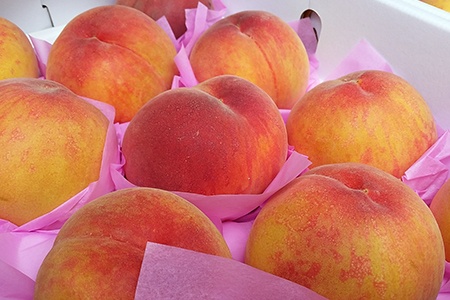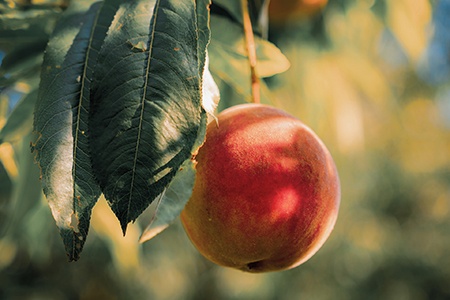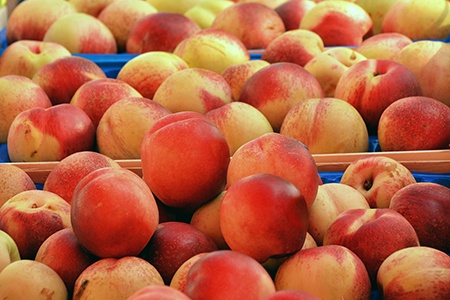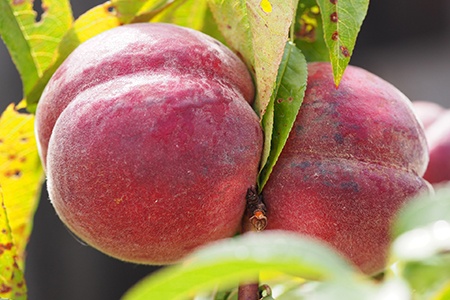39 Types of Peaches to Explore This Summer & Autumn
Author: Jen Worst | Editor: Omar Alonso
Review & Research: Jen Worst & Chris Miller

Whether you like your peach in pies or smoothies or just as is, there are numerous types of peaches to choose from. In the U.S. alone, there are more than 300 varieties of peaches. The possibilities are endless!
When one thinks of summer fruits, peaches instantly come to mind. Juicy, sweet, and packed with nutrients and antioxidants, peaches are a delectable summer treat that is healthy to boot.
Note that the availability of these fruits mainly depends upon your locality, so you might not find them readily in your area's grocery stores.
39 Types of Peaches
Did you know peaches originate from China, being domesticated almost 4000 years ago. China now produces 32% of all peaches in the world. In the 1980's, a survey team found a Tibetan peach tree with a 30 foot circumference trunk that was 65 feet tall, thought to be around 1000 years old.
Peaches are stone fruits, meaning their flesh grows around a seed in the center. All peaches can generally be categorized into one of three categories based on how they house their seeds or "pits": freestone, clingstone, or semi-freestone. Let's have a closer look at each kind in turn.
Freestone Peaches

Freestone peaches are the most commonly found type of peach in supermarkets. Thus, they are named for the ease with which their flesh falls away from the pit when the peach is taken apart.
Freestone peaches tend to be larger than others, although they are not as juicy as clingstones or semi-freestones. The flesh of a freestone peach will usually be yellow or white.
Freestone peaches are great for both eating fresh as well as for putting in baked goods. They can also be canned and preserved very easily. They're easy to slice and have a more subtly sweet taste.
Here are some popular freestone peach types.
Early Amber Peaches

Characterized by dark red and yellow skin, early amber peaches originate in Florida. These different types of peaches are sweet and delicious, although their texture is somewhat firm.
Nectarines

Nectarines are wrongly classified as a different kind of fruit. In actuality, they are a variety of peaches that have been bred not to have any fuzz. Nectarine trees make very satisfying types of fruit trees to grow at home.
They're super sweet and juicy, and they might have white or yellow flesh. Some nectarine varieties are also classified as clingstone. Some of the most common nectarine varieties are Harko, Nectar Babe, and Southern Belle.
El Dorado Peaches

The trees on which El Dorado peaches grow are classified as dwarf trees due to their short size.
The fruit they yield, however, is medium-sized. If you want to make some peach desserts, go with El Dorado peaches.
Honey Babe Peaches

Small and soft, Honey Babe peaches have yellow flesh and a near-complete lack of acidity in their flavor.
Forty-Niner Peaches

Soft and delicate yet generously sized, Forty-Niner peaches are grown in the eternally sunny state of California, which perhaps explains their yellow skin. Although these peaches aren't particularly sweet, they're still very rewarding to eat!
August Pride Peaches

Also grown in California, August Pride types of peaches are large with a light yellow flesh and soft red skin.
Madison Peaches

Madison peaches are recognized for the beautiful coloring of their flesh, which transitions from dark yellow to red as it approaches the pit.
Madison peaches are intensely sweet and delicious, making them irresistible to eat as is. However, they're also great candidates for preservation, as their flesh is tougher than many other freestone types.
Ventura Peaches

We have another California-grown peach in the Ventura, which has a small, oblong shape. It's easily marked by its deep red skin, which turns yellow when it fades.
Ventura peaches are pretty sweet, but their slightly acidic flavor might be unbecoming to some.
Tropic Snow Peaches

So, named for their harvestability early in the year, tropic snow peaches sport bold red skin and have yummy white flesh.
Polly Peaches

Polly peaches are easy to grow in non-warm climates, giving them their medium size and juicy flesh.
Reliance Peaches

These are grown in New Hampshire and have a mixed skin of yellow and red. The flesh, too, is yellow, as well as juicy. These types of peaches are a fantastic choice if you live in the New England area.
Clingstone Peaches

Contrary to freestone peaches, clingstone varieties are those in which the flesh is more difficult to separate from the seed.
This is easily compensated for in their unparalleled juiciness, sweetness, and softness, which you won't find in any other peach type.
The flesh of a clingstone peach might be bright red or yellow with a crisp texture and somewhat acidic (sour-leaning) flavoring.
Unfortunately, clingstone peaches are difficult to find in stores due to their widespread commercial value, but you might get lucky at your farmer's market or real lucky if you're into backyard farming.
If you do get your hands on some of these guys, though, you're in luck! They're great for turning into the sweetest types of jam or blending into beverages, but they're amazing when eaten fresh as well.
Let's have a look at some of the most common and popular varieties of clingstone peach.
Peento Peaches

These delicious, flat-shaped peaches are most commonly found in the states of Washington and California, a long way from their birthplace in China. Their skin tends to have an orange, red, and/or yellow coloring.
Cardinal Peaches

So, named for their resemblance to the bright red bird species, Cardinal peaches are sweet without being overpowering. Their flesh is firm, making them an excellent choice for producing preserves.
Cresthaven Peaches

Cresthaven peaches, which are highly juicy and sweet, tend to be larger than most other peach varieties.
These types of peaches are also tougher, having firm flesh that is difficult to bruise. This gives these peaches a longer shelf life than many other peach varieties, so once again, they're perfect for making jams and preserves.
Melba Peaches

Melba peaches go in — you guessed it — peach melba! This delicious peach dessert is loved all over the nation. Melba peaches are usually cut down the middle before being poached for ice cream, pie, or puree.
Melba peaches are characterized by their large size and delicious white flesh, covered in yellow skin.
Arctic Supreme Peaches

This clingstone peach is highly flavorful and has beautiful and tasty white flesh on the inside. Its skin is a mixture of red and cream. A lot of these white flesh peaches can be similar in texture to the various types of cantaloupe.
White Health Cling Peaches

The white and red coloring of white health cling peaches gives them a unique look. They are large and have juicy and soft white flesh inside. This type of peach is usually grown in Maryland.
Snow Beauty Peaches

Another very large variety of peach is the snow beauty peach. Their lovely red skin has a stunning contrast against the white flesh inside. You'll love eating Snow Beauty peaches fresh by hand!
Semi-Freestone Peaches
It is the ultimate choice in peaches if you're caught between clingstones and freestones.
They're almost as sweet and juicy as clingstones, with flesh that is easily removed.
This means that semi-freestone peaches are not only perfect for eating fresh but ideal for cooking and baking purposes as well.
And yes, they take wonderfully to being canned and preserved, too! Let's have a look at some varieties of semi-freestone peach most commonly sought and found.
Babcock Peaches

The fuzzy skin of peaches makes them somewhat unpalatable to some people. If you're one of them, then you'll love Babcock peaches, which have smooth, fuzz-free skin.
Although these types of peaches are small, they are delicious, offering a tantalizing flavor combination of tangy and sweet.
Donut Peaches

You may have already heard of donut peaches, which are so named due to their saucer-like, flat shape. Although they are mainly clingstone peaches, they are also available in semi-freestone varieties.
Although they taste pretty good and have a low acidity level, their only real specialty seems to be their adorable shape — so be careful not to pay extra for donut peaches, even if they are hard to come by. Donut peaches are most easily found during the summer.
You'd think somebody has tried it by now, but I've never heard of any donut peach types of donuts, so they must either not taste that great in that baked format or we just came up with a brand new idea.
Red Haven Peaches

Another non-fuzzy peach variety is the red haven peach. Its flesh, which has a delicious creamy texture, is a very satisfying yellow color.
Easy to grow and care for, red haven peaches are an excellent choice for home gardeners who want to add a peach tree to their garden. Red Havens are also a good choice for preserving purposes.
Coronet Peaches

Coronet peaches have soft yellow flesh that tastes quite acidic, that is to say tangy, to taste. Despite this, their use in peach dishes, desserts, and products is widespread.
Other Types of Peaches
One could argue that some of the different types of peaches we're about to share below could fit into the categories above, but we're keeping them separated. This is partially because they're rare and hard to find, and because they're just slight variations.
Doughnut Peaches

Doughnut peaches are one of the heirloom peach varieties, having a flat shape like a doughnut or small pumpkin.
The flesh is white and not very acidic, which really accentuates the sweetness. These kinds of peaches are hard to find unless you have a farmer's market that carries them, usually around July to August.
Melting Flesh Peaches

The reason these are named 'melting flesh' is because these kinds of peaches have flesh that really falls apart once the skin is removed. You have to be careful even cutting them with a knife because you'll end up mushing them more than anything.
You can get these in freestone and clingstone varieties. They're hard to eat raw, so you're better off including them in pies or cobblers.
Arctic Supreme Peaches

Another type of clingstone peach, the arctic supreme peach is pretty large relatively and has a white, soft flesh. The outside skin is red and creamy and equally enjoyable.
Baby Crawford Peaches

Baby Crawford peach types have a sweet, yellow flesh within their gold and orange skins. They're one of the smaller varieties of peaches, which is why they have the 'baby' modifier tacked on the front of their name.
Frost Peaches

If you want peaches all the way into the late portions of the season, the frost types of peaches are a great choice because this is when they bloom. They have a reddish skin that contains their tangy, yellow flesh. They're medium-sized and make for a great snack.
Halloween Peaches

These peaches mature and are ready for harvest around late October, which is why they have the name they do. They're pretty big and easy to spot. Their yellow skin is blushed with portions that are red all the way to dark brown.
They look like something you'd see around Halloween time. They have a yellow flesh that's as pleasant to taste as any other.
Rio Grande Peaches

The Rio Grande peach is a freestone type that was developed in Florida. You can grab them and eat them with no other consideration (maybe other than rinsing off). Their flesh is yellow and has a really fine, smooth texture.
Southern Sweet Peaches

These kinds of peaches almost look like apples in that they have a red and yellow skin and are about the same medium size as an apple. Their name might confuse you because these actually come from California.
Angelus Peaches

These are fairly large and more elongated than perfectly round. They're a freestone peach with yellow flesh and a yellow skin with a slight blue hue to them. They're harvested later in the midseason.
They have a milder flavor, great for canning, baking, or eating right off the tree. The texture is more coarse than you might expect.
It can get damaged or ruined in shipping easily so good luck finding it unless you live near the orchards. If you grow them yourself make sure you know the best time to plant fruit trees so you get the highest yield.
Contender Peaches

This medium sized freestone peach has a yellow flesh and orange skin. It's ripe in mid-season and is extremely tasty. They're perfect to grow in your garden if you live in the north due to being hardy and disease resistant. They're self-pollinating too, which makes it a breeze.
Elberta Peaches

These are large freestone types of peaches with a golden skin that's blushed with red all over. Open it up to reveal the delicious yellow flesh that's firm and very rich to the taste. These aren't hard to find and they're grown down in Georgia.
Empress Peaches

Another large freestone, the Empress has a pink-to-red skin tone with a yellow flesh. It's ready to eat late in the season, which extends our enjoyment much longer. Because this is an excellent peach to taste and take your time with.
It's very sweet with a lot of juices, so have a napkin ready. Many of these red peaches that get dark enough start to have purple skin and could easily be confused with some of the types of plums out there.
Fairhaven Peaches
This yellow fleshed, above average sized freestone peach is ripe in midseason. It's tasty enough, but it's skin makes it more attractive, being yellow with red blushed cheeks on the sides.
These kinds of peaches are a globular fruit, and while the flesh is yellow, as you move towards the pit it gets more red. The flesh is pretty firm though the texture is pretty fine. It resists browning, so freezing or canning is a good move with these.
Glohaven Peaches

Glohaven peaches are large freestone peach varieties with yellow flesh and yellow skin. They're brighter than most yellow peaches which is why they have "glow" in the name. They're really smooth too with nearly no fuzz or hair.
Harken Peaches

This medium sized, freestone peach has red skin that hides yellow flesh. The flesh doesn't brown if you don't get to it right away. It's among one of the highest rated peaches for Washington state.
Indian Blood Peaches

This heirloom peach from Mexico is a medium sized clingstone peach. It's red skin hides yellow flesh that has red streaks through it, which is where the name comes from. The Spanish brought it to Mexico in the 1500's.
The skin is tough, more like a beet. The flesh is stringy and meaty, but despite this it has a very pleasant flavor.
Even More Types of Peaches
We could seriously do this all day. Instead, we'll leave you some scavenger hunt fun to find out about more of the various peach types like...
GaLa, Galaxy, Garden Gold, Garnet Beauty, Gold Dust, Honey Babe, J.H. Hale, John Boy, Loring, Lucky 13, May Pride, Newhaven, Pix Zee, Red Baron, Redglobe, Red Haven, Santa Barbara, Southern Flame, Springprince, Stark Saturn, Summerset, Suncrest, Sun Haven, Sunhigh, Sweet Dream, UF2000, UFGold, Veteran peaches, and Zee Lady.
Believe it or not, even after rambling off this last group of peach names, that's not even an exhaustive list. But just because these peach varieties exist doesn't mean you'll be able to track them down. Many are just slight variations of the main types listed above, so don't worry about trying each one.
Types of Peaches for Every Taste Palette
Whether yellow- or white-fleshed, enjoyed in a cobbler, or wolfed down whole, peaches are a summer delight that anyone can enjoy.
Thanks to numerous growing techniques and genetic experiments, multiple peach varieties are available according to different tastes and preferences. Whichever types of peaches you choose, we hope you enjoy it!



